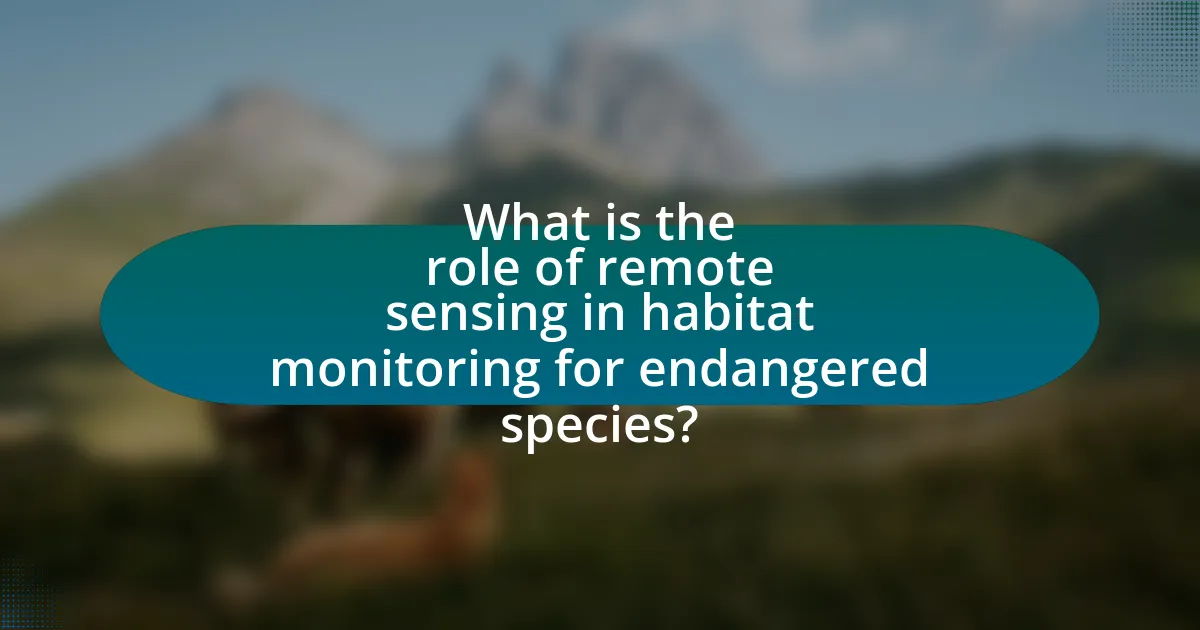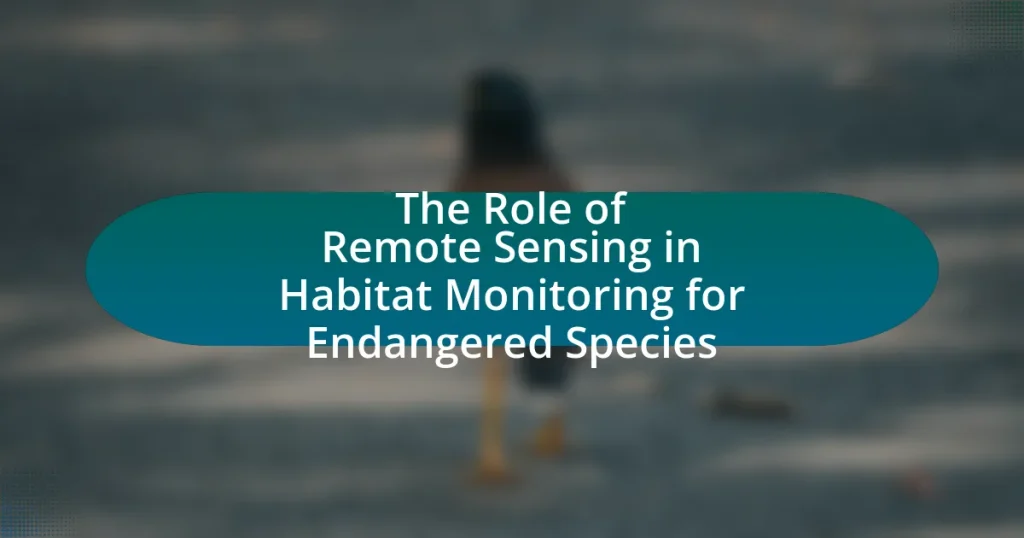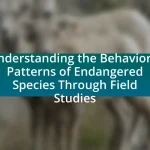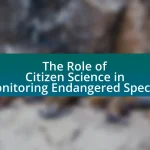Remote sensing is a vital technology for habitat monitoring of endangered species, providing extensive data on land use, vegetation cover, and environmental changes. It enables researchers to assess habitat conditions over large areas and timeframes, facilitating the identification of critical habitats and threats such as habitat fragmentation and degradation. Various technologies, including satellite imagery, aerial photography, LiDAR, and drones, enhance data collection and analysis, supporting conservation efforts by allowing timely interventions and informed decision-making. The article explores the contributions of remote sensing to habitat monitoring, the challenges faced, and future developments that can improve its effectiveness in protecting endangered species.

What is the role of remote sensing in habitat monitoring for endangered species?
Remote sensing plays a crucial role in habitat monitoring for endangered species by providing comprehensive data on land use, vegetation cover, and environmental changes. This technology enables researchers to assess habitat conditions over large areas and timeframes, facilitating the identification of critical habitats and potential threats. For instance, satellite imagery can reveal habitat fragmentation and degradation, which are significant factors affecting endangered species’ survival. Studies have shown that remote sensing can enhance conservation efforts by enabling timely interventions and informed decision-making, ultimately contributing to the protection and recovery of endangered species populations.
How does remote sensing contribute to habitat monitoring?
Remote sensing significantly contributes to habitat monitoring by providing detailed and timely data on land cover, vegetation health, and environmental changes. This technology utilizes satellite imagery and aerial sensors to capture information across large areas, enabling researchers to assess habitat conditions and track changes over time. For instance, studies have shown that remote sensing can detect shifts in vegetation patterns, which are critical for understanding the habitat needs of endangered species. Additionally, remote sensing facilitates the monitoring of habitat fragmentation and degradation, allowing conservationists to implement targeted management strategies.
What technologies are used in remote sensing for habitat monitoring?
Remote sensing for habitat monitoring employs technologies such as satellite imagery, aerial photography, LiDAR (Light Detection and Ranging), and drones. Satellite imagery provides large-scale data on land cover and vegetation changes, while aerial photography captures detailed images of specific areas. LiDAR technology enables precise topographical mapping and vegetation structure analysis, which is crucial for understanding habitat characteristics. Drones offer flexibility and high-resolution data collection, allowing for targeted monitoring of endangered species habitats. These technologies collectively enhance the ability to assess and manage habitats effectively, supporting conservation efforts.
How does remote sensing improve data collection for endangered species?
Remote sensing enhances data collection for endangered species by providing comprehensive, real-time information about their habitats and populations. This technology utilizes satellite imagery and aerial surveys to monitor environmental changes, track species movements, and assess habitat conditions without the need for invasive field studies. For instance, studies have shown that remote sensing can detect habitat loss due to deforestation or climate change, enabling conservationists to respond swiftly. Additionally, remote sensing can identify critical habitats and migration corridors, which is essential for effective management and protection strategies.
Why is habitat monitoring crucial for endangered species?
Habitat monitoring is crucial for endangered species because it provides essential data on environmental conditions and threats that affect their survival. By systematically observing changes in habitat, conservationists can identify factors such as habitat loss, climate change, and human encroachment that jeopardize these species. For instance, studies have shown that habitat degradation is a leading cause of species extinction, with approximately 80% of terrestrial species at risk due to habitat destruction. Monitoring allows for timely interventions, such as habitat restoration and protection measures, ensuring that endangered species have the necessary resources to thrive.
What are the main threats to endangered species habitats?
The main threats to endangered species habitats include habitat destruction, climate change, pollution, invasive species, and overexploitation. Habitat destruction, primarily due to urban development and agriculture, leads to significant loss of natural environments, impacting species survival. Climate change alters temperature and precipitation patterns, further threatening habitats. Pollution from chemicals and waste degrades ecosystems, while invasive species outcompete native flora and fauna, disrupting local biodiversity. Overexploitation through hunting and fishing depletes populations, making it difficult for species to recover. According to the World Wildlife Fund, habitat loss is the leading cause of species extinction, affecting over 80% of threatened species globally.
How does habitat loss impact endangered species populations?
Habitat loss significantly reduces endangered species populations by diminishing their living space and resources necessary for survival. When habitats are destroyed or fragmented, species face increased competition for food, shelter, and mating opportunities, leading to population declines. For instance, studies show that habitat destruction has contributed to the decline of over 80% of threatened species, as reported by the International Union for Conservation of Nature (IUCN). Furthermore, habitat loss can isolate populations, reducing genetic diversity and increasing vulnerability to extinction.
What are the key benefits of using remote sensing in habitat monitoring?
The key benefits of using remote sensing in habitat monitoring include enhanced data collection, improved spatial analysis, and cost-effectiveness. Remote sensing allows for the acquisition of large-scale environmental data without the need for extensive field surveys, enabling researchers to monitor habitat changes over time efficiently. For instance, satellite imagery can capture land cover changes, providing insights into habitat loss or degradation, which is crucial for the conservation of endangered species. Additionally, remote sensing technologies can analyze habitat characteristics, such as vegetation density and moisture levels, facilitating better management decisions. Studies have shown that remote sensing can reduce monitoring costs by up to 50% compared to traditional methods, making it a valuable tool for conservation efforts.
How does remote sensing enhance conservation efforts?
Remote sensing enhances conservation efforts by providing detailed and timely data on habitat conditions and changes. This technology allows conservationists to monitor ecosystems, track wildlife populations, and assess the impacts of human activities on natural habitats. For instance, satellite imagery can reveal deforestation rates, habitat fragmentation, and land-use changes, enabling targeted interventions. Studies have shown that remote sensing can improve the accuracy of species distribution models, which are crucial for effective conservation planning. By integrating remote sensing data with ground-based observations, conservationists can make informed decisions that lead to more effective protection of endangered species and their habitats.
What cost advantages does remote sensing provide over traditional methods?
Remote sensing offers significant cost advantages over traditional methods by reducing the need for extensive fieldwork and enabling large-scale data collection. Traditional methods often require labor-intensive surveys, which can be time-consuming and expensive, whereas remote sensing allows for the acquisition of data over vast areas quickly and efficiently. For instance, satellite imagery can cover hundreds of square kilometers in a single pass, significantly lowering the per-unit cost of data collection compared to ground surveys that may only cover small areas at a higher cost. Additionally, remote sensing technologies, such as drones and satellites, can provide continuous monitoring, which minimizes the costs associated with repeated field visits and manual data collection. This efficiency not only saves money but also enhances the ability to monitor changes in habitats over time, making remote sensing a more economically viable option for habitat monitoring of endangered species.
How can remote sensing data be effectively utilized in conservation strategies?
Remote sensing data can be effectively utilized in conservation strategies by providing detailed information on habitat conditions, species distribution, and environmental changes. This technology enables conservationists to monitor ecosystems over large areas, assess habitat loss, and identify critical areas for protection. For instance, satellite imagery can reveal deforestation rates, allowing for targeted interventions in regions experiencing rapid habitat degradation. Additionally, remote sensing can track changes in land use and climate, which are crucial for adapting conservation strategies to shifting environmental conditions. Studies have shown that integrating remote sensing data with ground-based observations enhances the accuracy of species habitat models, thereby improving conservation planning and management efforts.
What challenges are associated with remote sensing in habitat monitoring?
Remote sensing in habitat monitoring faces several challenges, including data resolution limitations, atmospheric interference, and the complexity of ecological variables. Data resolution limitations can hinder the ability to detect small-scale habitat changes, as many remote sensing technologies operate at coarse spatial resolutions. Atmospheric interference, such as clouds and haze, can obstruct satellite imagery and reduce the accuracy of habitat assessments. Additionally, the complexity of ecological variables, including species behavior and habitat dynamics, complicates the interpretation of remote sensing data, as these factors may not be easily quantifiable through remote sensing alone.
How can data accuracy be ensured in remote sensing applications?
Data accuracy in remote sensing applications can be ensured through rigorous calibration and validation processes. Calibration involves adjusting the sensor data to match known reference values, while validation compares the remote sensing data against ground truth measurements to assess accuracy. For instance, studies have shown that using high-resolution satellite imagery alongside field data can significantly enhance the precision of habitat assessments for endangered species, as demonstrated in research published in the journal “Remote Sensing of Environment” by Turner et al. (2015), which highlights the importance of integrating multiple data sources for improved accuracy.
What are the limitations of remote sensing technologies?
Remote sensing technologies have several limitations, including issues with spatial resolution, temporal resolution, and data interpretation. Spatial resolution can restrict the ability to detect small or subtle habitat features, as many sensors may not capture fine details necessary for monitoring endangered species. Temporal resolution refers to the frequency of data collection, which can limit the ability to observe dynamic changes in habitats over time, particularly in rapidly changing environments. Additionally, data interpretation can be challenging due to atmospheric interference, sensor calibration issues, and the need for ground-truthing to validate remote sensing data. These limitations can hinder effective habitat monitoring and management for endangered species.
What future developments can enhance remote sensing for habitat monitoring?
Future developments that can enhance remote sensing for habitat monitoring include advancements in satellite technology, such as higher resolution imagery and improved multispectral sensors. These technologies enable more precise data collection on habitat conditions and species distributions. For instance, the launch of the European Space Agency’s Sentinel satellites has significantly improved the ability to monitor land cover changes and vegetation health, providing critical data for conservation efforts. Additionally, the integration of artificial intelligence and machine learning algorithms can enhance data analysis, allowing for real-time monitoring and predictive modeling of habitat changes. These developments collectively improve the accuracy and efficiency of habitat monitoring, which is essential for the conservation of endangered species.
How might advancements in technology improve remote sensing capabilities?
Advancements in technology can significantly improve remote sensing capabilities by enhancing data collection accuracy, increasing spatial and temporal resolution, and enabling real-time data processing. For instance, the development of high-resolution satellite imagery and drones equipped with advanced sensors allows for more precise monitoring of habitats, which is crucial for tracking endangered species. Additionally, the integration of artificial intelligence and machine learning algorithms facilitates the analysis of vast datasets, enabling quicker identification of changes in habitat conditions. According to a study published in the journal “Remote Sensing of Environment,” the use of machine learning techniques has improved classification accuracy of land cover types by over 90%, demonstrating the effectiveness of these technological advancements in remote sensing applications.
What role does machine learning play in analyzing remote sensing data?
Machine learning plays a crucial role in analyzing remote sensing data by enabling the automated extraction of meaningful patterns and insights from large datasets. This technology enhances the ability to classify land cover, detect changes over time, and identify specific features relevant to habitat monitoring for endangered species. For instance, machine learning algorithms can process satellite imagery to distinguish between different vegetation types, assess habitat quality, and monitor the impacts of environmental changes. Studies have shown that machine learning techniques, such as convolutional neural networks, can achieve high accuracy in classifying land use and detecting deforestation, which is vital for conservation efforts.
What best practices should be followed when implementing remote sensing for habitat monitoring?
Best practices for implementing remote sensing for habitat monitoring include selecting appropriate sensors, ensuring high spatial and temporal resolution, and integrating ground-truth data. Appropriate sensors, such as multispectral or hyperspectral imagery, provide detailed information about vegetation types and health, which is crucial for monitoring habitats. High spatial resolution allows for the detection of small-scale changes in habitat, while high temporal resolution enables the tracking of seasonal variations and disturbances. Integrating ground-truth data, such as field surveys, enhances the accuracy of remote sensing analyses by validating satellite or aerial imagery findings. These practices collectively improve the reliability of habitat assessments, as evidenced by studies demonstrating that combining remote sensing with ground data significantly increases the accuracy of habitat classification (e.g., Turner et al., 2015, “Free and Open Access to Satellite Data: A New Era for Remote Sensing”).


